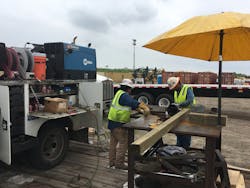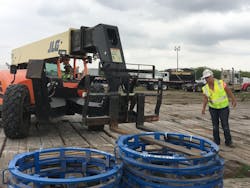Strike LLC: The Art of Dealing
Elliott Stanton, CEM, EMS, field fleet manager for Texas-based energy contractor Strike LLC, is a busy and popular man.
Above: Strike has negotiated on-site technicians as part of its equipment deals in order to avoid downtime and lower its risk for unplanned costs.
During a recent interview with CE, Stanton couldn’t last 10 minutes without having to respond to a phone call, email, or personal visit to his makeshift office in a trailer at the Ricardo, Texas, staging yard for a 200-mile-long installation of 48-inch gas pipeline. The line will run deep in the heart of Texas, from Agua Dulce to Brownsville and the Gulf of Mexico.
Strike LLC is the large-fleet winner of the 2017 Fleet Masters Award.
But what’s even more telling about Stanton and his service-oriented position is how he deals with the constant contact—every phone call, every visitor hears a “Yes, sir,” or “Yes, ma’am” from Stanton, no matter what job title is on the receiving end and no matter the question or request. And he says his own job title doesn’t matter.
“I’m lucky,” Stanton says. “I’m in the right place at the right time. They could call me me ‘Bozo the Clown’ and I’d still get the same job done.”
A large part of his job is dealing with equipment dealers. Strike has changed the way it makes deals for equipment, insisting on full warranties and on-site support from suppliers so Strike can control costs and limit downtime.
“When a pipeline company comes to town, there’s an extreme amount of revenue tied up in machinery,” Stanton says. “Nobody can afford downtime, whether you are building a parking lot, a hospital, or a pipeline, but when you’ve got 1,500 employees and the assembly line stops, you can’t pay those guys.
“We had a bus go down one day with a fuel de-rate issue and the driver drove employees back from the line to the yard—it cost us $15,000 for two hours just to pay the welders to sit on the bus when it was doing 15 mph,” Stanton says. “So there’s a huge cost associated with having something go down.”
Prior to an equipment deal negotiated in 2015 for delivery in 2016, Strike often received fairly standard terms.
“Previously, it was a full machine warranty the first year on powertrain and hydraulics, but we ran into problems with Tier 4-Interim wiring harnesses rubbing, or electronic failures,” Stanton says. “That wasn’t covered under powertrain or hydraulics, so we were left with two things: a high repair bill and extreme downtime.
“You only have to learn a lesson one time before you find another way, and since that package, our buying has morphed,” Stanton says. “Now, each time we buy, it has become better and better. The job appreciates it, the guys appreciate it, and it’s allowed us to have better control on our equipment.”
For the 2016 package, Strike negotiated full machine warranties for the entire time they forecasted owning the equipment.
“At Strike, our oldest asset you’re going to find, unless it’s something highly specialized, is about 3 years old,” Stanton says. “Very seldom does something make it to 4 years. At 3 years, we’re flipping it and we’re into something else.
“So we said let’s get a full machine warranty this time. If the AC line ruptures, it’s only a $250 deductible,” Stanton says. “Our cost is controlled on machine repairs. And also what it allowed us to do in that package, if one of the dealers can’t get a machine running, they’re bringing another tractor out there. Worst-case scenario, in 24 hours there’s another tractor running. So we cut down on downtime in the job and cut down on surprise repair bills.
The equipment buy for Strike’s current project included 32 Volvo E Series pipelayers (Strike also rented eight more from the local dealer), 15 Komatsu D85s, and 35 Komatsu 490s. The terms not only included full machine warranties for 3,000 hours, but also two technicians on site.
Elliott Stanton, CEM, is a member of the 2017 class of Under 40 in Construction Equipment.
“Our local Komatsu dealer, Kirby-Smith, has a pipeline division,” Stanton says. “They go where the pipe goes. They’ve got a parts guy on site in the building next door. They probably have $1 million worth of parts in this yard alone, for anything that could possibly go wrong. Of the two mechanics on site, one is a lube tech. He’s basically doing services wherever a Komatsu goes and needs service.”
The lube tech has to be mobile because pipeline production is constantly moving and he could be needed anywhere along the assembly line. Strike is doing the entire project turnkey, and in pipeline work that means grading, stringing, welding, trenching, and placing.
“In the pipeline world, you never want to be in one place too long,” Stanton says. “Every day, the goal is to move a mile or so.”
And when that movement is in jeopardy, Stanton gets a phone call. “The hardest part of the job is that there are a lot of moving parts,” he says. “Everybody has got to be No. 1. ‘I need this moved now, I need this fixed.’ Well, you can have five things break down at once, and there’s only one mechanic, so five people need a mechanic right away. Who gets that mechanic?
“You’ve got to use your gut to decide what the most important thing is today. The biggest thing is to try to keep everybody afloat. You never want to stop production. When you stop the assembly line, you’re literally paying people not to do something and the gas company can fine us for not making enough progress in a day. You’re getting it from both ends,” Stanton says.
“The analogy I like to tell people is that Strike is like a grandfather clock; everybody’s job here is a little piece of that clock and we all have to work together to keep the time and keep it accurate. It’s really the ultimate team experience.”

